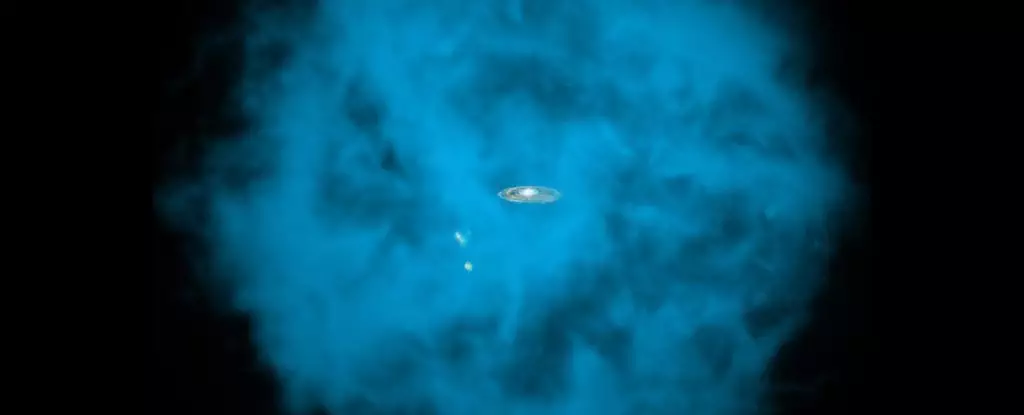In an exciting breakthrough, a group of astronomers and astrophysicists has finally unveiled a significant component of our Universe that has long been considered missing: the baryonic matter. This newly confirmed presence in the cosmos takes the form of vast, invisible clouds of ionized hydrogen scattered in the intergalactic space around galaxies. For decades, scientists grappled with the puzzle of incomplete baryonic matter — the luminous substance that makes up stars, planets, and living beings. Current findings reveal that this matter is not just absent but is, in fact, residing in a diffuse ‘mist’ much farther from galaxy centers than previously speculated.
The implications of this discovery extend far beyond simple curiosity; they challenge existing cosmic models and theories of galaxy evolution. “By increasing the observational limits, we may solve more mysteries,” observes Boryana Hadzhiyska from the University of California, Berkeley. The claim suggests that the deeper we venture into the cosmos, the more gaseous matter we can potentially recover. This evidence is crucial because it speaks to the fundamental makeup of the Universe: baryonic matter constitutes roughly 5% of the total matter-energy content, with much of it still elusive.
The Complexity of Cosmic Matter
Understanding the essence of baryonic matter illuminates several critical aspects of astrophysical research. Primarily, hydrogen — accounting for an astonishing 90% of the Universe’s atomic composition — is a significant part of this lost matter. Yet, in the vastness of space, it remains challenging to detect these ionized hydrogen clouds due to their faint luminescence and dispersed nature across vast distances. The hydrogen gas is difficult to observe because radiation can ionize it, thereby causing it to emit light, but it becomes far too diffused to be visible when stretched across intergalactic distances.
To uncover these clouds, scientists have harnessed an innovative approach involving observations of the cosmic microwave background (CMB) — the remnant glow of the Big Bang that is interwoven throughout the universe. Simone Ferraro, a cosmologist at the Lawrence Berkeley National Laboratory, describes this process as utilizing the cosmic light as a ‘backlight.’ As this light interacts with the hydrogen clouds, it can either brighten or dim depending on the gas it travels through. This method, known as the kinematic Sunyaev-Zel’dovich effect, allows for the detection of otherwise invisible matter, even if it remains intrinsically faint.
The Technical Mastery Behind The Discovery
The technique employed by this research team involved a clever stacking method, where observations of over a million glowing red galaxies were layered on top of each other. This multi-layering serves to illuminate even the subtlest details hidden within the faint intergalactic hydrogen. The results illuminated that the hydrogen halos encircling these galaxies are significantly more extensive than previously estimated, hinting at the possibility of even larger undetected reservoirs of hydrogen.
Such revelations spark stimulating questions regarding the dynamic processes within galaxies and their supermassive black holes. The interaction between hydrogen and expelled gas from black holes may influence star formation rates and hint at the episodic nature of black hole activity. With supermassive black holes effectively regulating their surroundings through powerful jets and winds, new questions arise about the evolution of galaxies. Do black holes cycle between dormancy and active phases, and how does this affect their host galaxies and the universe at large?
Ties to Dark Matter and Cosmic Evolution
The revelations from this study complement ongoing efforts to map out the Universe’s elusive baryons. Researchers suspect that some of this missing gas may be tangled within the extensive filaments of dark matter that form the cosmic web. This interconnected fabric links galaxies across colossal distances and plays an essential role in shaping cosmic structures. Understanding the dynamic between dark matter and baryonic gas is paramount for painting a more comprehensive picture of how galaxies form and evolve over cosmic timescales.
This research lays the groundwork for further investigations into cosmic dynamics and encourages a broader discourse within the scientific community to refine existing theories on galaxy formation. The work not only opens new avenues for studying baryonic matter but also invites further inquiry into the interconnected nature of gas, dark matter, and the growth of galaxies. The cosmos continues to intrigue, promising more secrets waiting to be uncovered, as humanity strives to comprehend its vast and enigmatic nature.


Leave a Reply